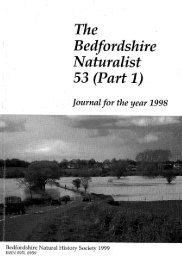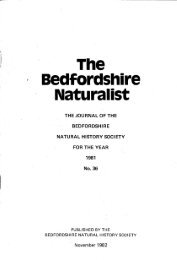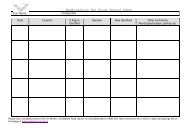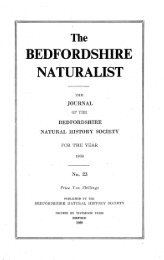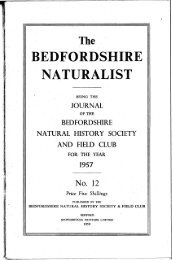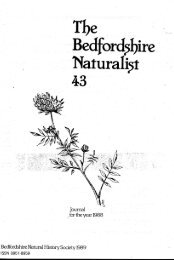1997 No. 52 Part 1 - Bedfordshire Natural History Society
1997 No. 52 Part 1 - Bedfordshire Natural History Society
1997 No. 52 Part 1 - Bedfordshire Natural History Society
You also want an ePaper? Increase the reach of your titles
YUMPU automatically turns print PDFs into web optimized ePapers that Google loves.
<strong>Bedfordshire</strong> <strong>Natural</strong>ist for <strong>1997</strong>, <strong>No</strong>. <strong>52</strong> (<strong>Part</strong> 1) (1998)<br />
MAMMALS<br />
by CliffTack<br />
Review of <strong>1997</strong><br />
Once again records were received from nearly one hundred observers and it is thanks<br />
to them that we can publish such a detailed mammal report.There were 28 species<br />
recorded during the year with another 450 tetrads marked onto the distribution maps.<br />
For the first three years ofthe survey we now have 2,560 tetrads mapped for 34<br />
species. This· is a fantastic effort by all concerned and I send my thanks to them all<br />
whether an observer with a single record or the stalwarts with many.<br />
Red-neckedWallabies have become a regular feature ofthe mammal reports in<br />
recent years and <strong>1997</strong> was no exception.With three records during the year there must<br />
be a continuous escape from captivity or an ability to live wild in <strong>Bedfordshire</strong>.<br />
There were two more species ofexotica reported during the year namelyWild Boar,<br />
Sus scrofa, and Mara, Dolichotis patagona. Together with a belated 1996 report of<br />
Chipmunks, Eutamias sp.,it seems there is no end to what can turn up in <strong>Bedfordshire</strong>.<br />
We welcome all records just in case a species mirrors the success in establishing itselfof<br />
Grey Squirrel or Muntjac Deer.<br />
Small mammal records were abundant in <strong>1997</strong> withYellow-necked Mouse being<br />
reported from three sites. The difficulty in identifying them fromWood Mice probably<br />
masks their true distribution. Another pleasing record was that Dormouse was found in<br />
another tetrad in the county. Its relative the Fat or Edible Dormouse was found in<br />
three more tetrads and early indications are that it is increasing in <strong>Bedfordshire</strong> which<br />
is at the northern mbst part ofits very restricted ra~ge, perhaps aided by a series of<br />
mild winters.<br />
The carnivores in the county were all well recorded although the roads still take a<br />
heavy toll. Once again Badger road kills reached the 50 mark.<br />
Also, 11 ofthe 12 Ferret and Polecat records came from road kills. It is good to have<br />
the reports coming in but frustrating not to get more detail. Only two ofthe twelve<br />
were identified to a species so we really do need to collect the bodies or at least<br />
photograph them for identification purposes.With such a large number ofrecords it is<br />
probable that Polecat, Feral Ferret or perhaps both are breeding in <strong>Bedfordshire</strong>.We<br />
just need to prove it!<br />
Otter records are also increasing but as yet we have no evidence ofcubs being born<br />
in <strong>Bedfordshire</strong> to sustain the population. Dave Odell was lucky enough to see one in<br />
its riparian habitat whereas Linda Parsons saw hers crossing the new Bedford bypass.<br />
Unfortunately, her husband Dave, a county mammal enthusiast, was not with her at the<br />
time.<br />
Deer records were the only disappointment ofthe year with only three species<br />
recorded during <strong>1997</strong> against the six species we had in 1996. Having said that the three<br />
species we did record, Chinese Water, Fallow and Muntjac, all showed an increase in<br />
the number ofrecords and, like the majority ofmammals included in the report, seem<br />
to be doing well in <strong>Bedfordshire</strong>.<br />
24



